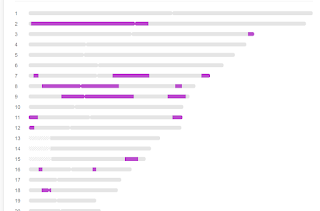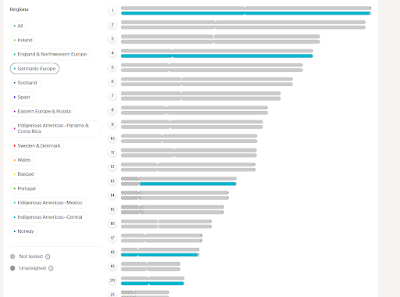We need tools to ensure we are interpreting our DNA results correctly. The best tools for this are a chromosome browser and well documented family trees.
In the case of a Pandemic the multi layered protection is used to plug any holes which may allow the virus through. The more layers the more likely holes are covered.
When using genetic genealogy to infer relationships we need to make sure we use multiple tools so we cover any holes which may lead to making false assumptions regarding how we are related to our matches.
Some say there is no way to say for certain where the segments we share with our matches come from. True, we cannot say where they originally came from but we can say who we received the segments from in the past few hundred years.
How do we ensure the segment is Identical by Descent?
Using shared matches
Looking at the single segment I share with my match below without any context it's meaningless.
Checking shared matches I add context for this matching segment. I tested my mother's DNA and she doesn't share this match but my paternal aunt does. Now I know the segment is from my paternal side. Since my aunt doesn't share this segment with our shared match I haven't confirmed it's IBD (Identical by Descent).
People who dismiss the use of a chromosome browser state that the likelihood of relatives and distant cousins sharing the exact same segments is low. Since many of our 3rd great-grandparent and generations earlier ancestors left many descendants the chances of sharing the same segment with others is good. It's just a matter of odds.
MyHeritage has some of the best DNA tools. Sometime after this first match showed up on my match list at MyHeritage I noticed an uncle of this original match showed up. Below you see my predicted relationships to my matches and their predicted relationships to each other.
I now check the original matches uncle's information. He is a generation back and shares even more segments with me. So now I have more than a single segment to compare with other matches. We see segments shared between my aunt and our original testers circled below. These segments are IBD and over 15cMs. My aunt being so close genetically to me we know the larger segments I share with her are IBD.
Using shared Ethnicity as another layer
It was pretty easy to determine how these two matches were related to us. Looking at the shared ethnicity our matches are predicted to be Eastern European/Balkan, and they are currently living in Austria. They also share the same genetic groups. My paternal grandfather Rudolph Kapple was born in Austria. Looking at shared matches with trees they also relate through the Burgenland area of Austria. Do they all have overlapping segments? No, but some do.
Trees are important but not always necessary
Having a well documented tree is important but not always possible. Can we confirm how we relate to this match without a tree? Looking at the trees a few shared matches posted they probably were related through my paternal great-grandmother Mary Kurta-Kappel's line? I contacted this match to confirm how these matches are related to us? Since the predicted relationship to my aunt was 2nd cousin to the older man I assumed they shared Kurt/Jost great-grandparents? Without a tree I didn't know for certain.
A documented tree was unnecessary in this particular case because one of the matches had photos of members of my own family sent to them by my great-grandmother. She sent them to her sister who returned to Austria. My great-grandmother, Mary, lived in Chicago until her death. One photo, among others, was taken in Chicago and my aunt June, who I knew very well, was in the photo.
 |
| Photo of Mary Kurta-Kappel and her grandchildren, June and Junior, owned by Austrian cousins |
Testing close relatives and second cousins helps us to find IBD segments and confirm them. Two 1rst cousins once removed on my paternal grandfather's side tested along with second cousins in that line allowing me to collect a number of segments to compare with matches, as you can see below. I know these segments are from my paternal grandfather. My paternal grandmother was Irish, English, Scots-Irish, and French Canadian and not Eastern European.
The segments I received from my Austro-Hungarian grandfather line up well with the chromosome ethnicity paint browsers at AncestryDNA and 23andMe. That is another confirmation that these segments are IBD.
A more difficult case
As you can see it takes analysis and use of a variety of tools to ensure we are drawing the right conclusions regarding how we are related to matches.
Segment information is important to collect because that is what matching is based on. It's a key piece of evidence just like a primary source document. You can use shared matches to predict how you are related to someone, but a collection of IBD segments actually makes identifying matches much quicker and more accurately. Once you've mapped your segments you can refer to that map every time a new match shows up you are interested in. You can also add newly discovered segments.
If you don't want to make a map you can generally use shared matches, with the chromosome browser, to identify the segment or segments.
I would recommend testing, or uploading your results, at all of the DNA companies if you are trying to break down a brick-wall. The company with the best tools is MyHeritage and I would definitely suggest testing with them or uploading your raw data there.
There can be holes, like those found in swiss cheese, when we use only one tool to trace our family trees. If we are interested in a tree with people who are genetically related to us DNA testing is necessary because of adoption and non paternity events. Of course in order to have a family tree we also need names collected from sources such as the census etc.. Layering all of this information we can produce a tree which accurately reflects our genetic family.



























